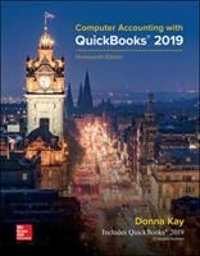Question
IFRS vs. U.S. GAAP Case Introduction IRS is becoming a constantly bigger part of accounting.When I first started in accounting, I would have sworn that
IFRS vs. U.S. GAAP Case
Introduction
IRS is becoming a constantly bigger part of accounting.When I first started in accounting, I would have sworn that the SEC and FASB would never consider giving up their control of accounting policies in the U.S.Now, however, the SEC allows companies reporting under IFRS to trade on the U.S. markets without a reconciliation to U.S. GAAP, the FASB is working in conjunction with the IASB to converge U.S. GAAP and IFRS, and the SEC is considering converting to IFRS so that we match most of the rest of the world.In addition, the new CPA exam will include IFRS questions.With all of these changes, it is imperative that new accountant have an understanding of the differences between U.S. GAAP and IFRS.
Unfortunately, we don't have the time in class to carefully consider each and every difference between the two standards.The most we can do it showcase some of the most important differences.The rest of the process of learning IFRS will eventually fall to you and your future employers.This case, however, attempts to help you in that process by providing you with an opportunity to put the two sets of standards side-by-side for comparison.The goals of the case are 1) to help you practice using IFRS in a real accounting setting and 2) to show you a direct comparison between the two standards.
Assignment
Read the following case and answer the questions provided. Your answers should be carefully formatted so that the TA or I can easily follow your work.
Grading
The grade on each write-up will be based on the following breakdown:
Classifying the Lease under both U.S. GAAP and IFRS
10 pts
Correctly using U.S. GAAP and IFRS
24 pts
Correctly making the adjustment from U.S. GAAP to IFRS
11 pts
Discussion of U.S. GAAP vs. IFRS
5 pts
Total
50 pts
Your write-up will be due in Blackboard by 11:00pm on the date listed in the course schedule.
Case Information
[1]
Background
On January 1, Year 8, Stainless Inc., which is involved in supply chain management (SCM), leased a specialized SCM computer system used for value-adding processing and logistics. The lease is non-cancelable, and Stainless Inc. will not receive title to the leased system during or at the end of the lease term. The terms of the lease contract are as follows:
Annual rentals, due at the beginning of the year: $1,254.
Lease term: 3 years.
Estimated economic life: 4.2 years and no residual value, as a new and superior system is expected on the market in March Year 12.
Purchase option for a price of $1,200, which approximates fair market value, at the end of three years. Stainless has not guarantee that value or committed to purchase the asset.
Fair market value at inception of the lease: $4,500.
Lessee's incremental borrowing rate: 8%
Stainless Inc. depreciates, on a straight line basis, other computer systems that it owns.
The SCM computer system is designed strictly for supply chain management and modified for the operating purposes at Stainless Inc.; it cannot be used for other purposes.
Stainless, Inc. is a company with a December 31 fiscal year end. The company spent $250 in upfront costs to create the lease.
Questions
Answer the following question:
How should Stainless, Inc. classify this lease under U.S. GAAP?
Based on your answer to the previous question, make Stainless Inc.'s journal entries for the lease in Year 8 and Year 9. (Do not worry about income taxes for this case.)
How should Stainless, Inc. classify this lease under IFRS?
Based on your answer to the previous question, make Stainless Inc.'s journal entries for the lease in years Year 8 and Year 9.
Assume that Stainless Inc. is a U.S. company that was bought out by a European company at the beginning of Year 10.At that time, Stainless had to report under IFRS instead of U.S. GAAP.Because of the change, Stainless has had to adjust its books for both Year 8 and Year 9 (since IFRS requires companies to report at least two previous years of data each year) and convert them to IFRS.Make one journal entry for each year (Year 8 and Year 9) to convert your U.S. GAAP entries into your IFRS entries, assuming that both sets of books are CLOSED.
Based on your entries and your understanding of U.S. GAAP and IFRS, which method (U.S. GAAP or IFRS) more appropriately presents the economic reality of this transaction?Defend your answer.
[1] This case is from Gornik-Tomaszewski, S., and T. Sellhorn. Case Study "Tomsel Corp." First-Time Adoption of International Financial Reporting Standards by U.S. Company. Review of Business 31 (1):22-33.
Step by Step Solution
There are 3 Steps involved in it
Step: 1

Get Instant Access to Expert-Tailored Solutions
See step-by-step solutions with expert insights and AI powered tools for academic success
Step: 2

Step: 3

Ace Your Homework with AI
Get the answers you need in no time with our AI-driven, step-by-step assistance
Get Started


